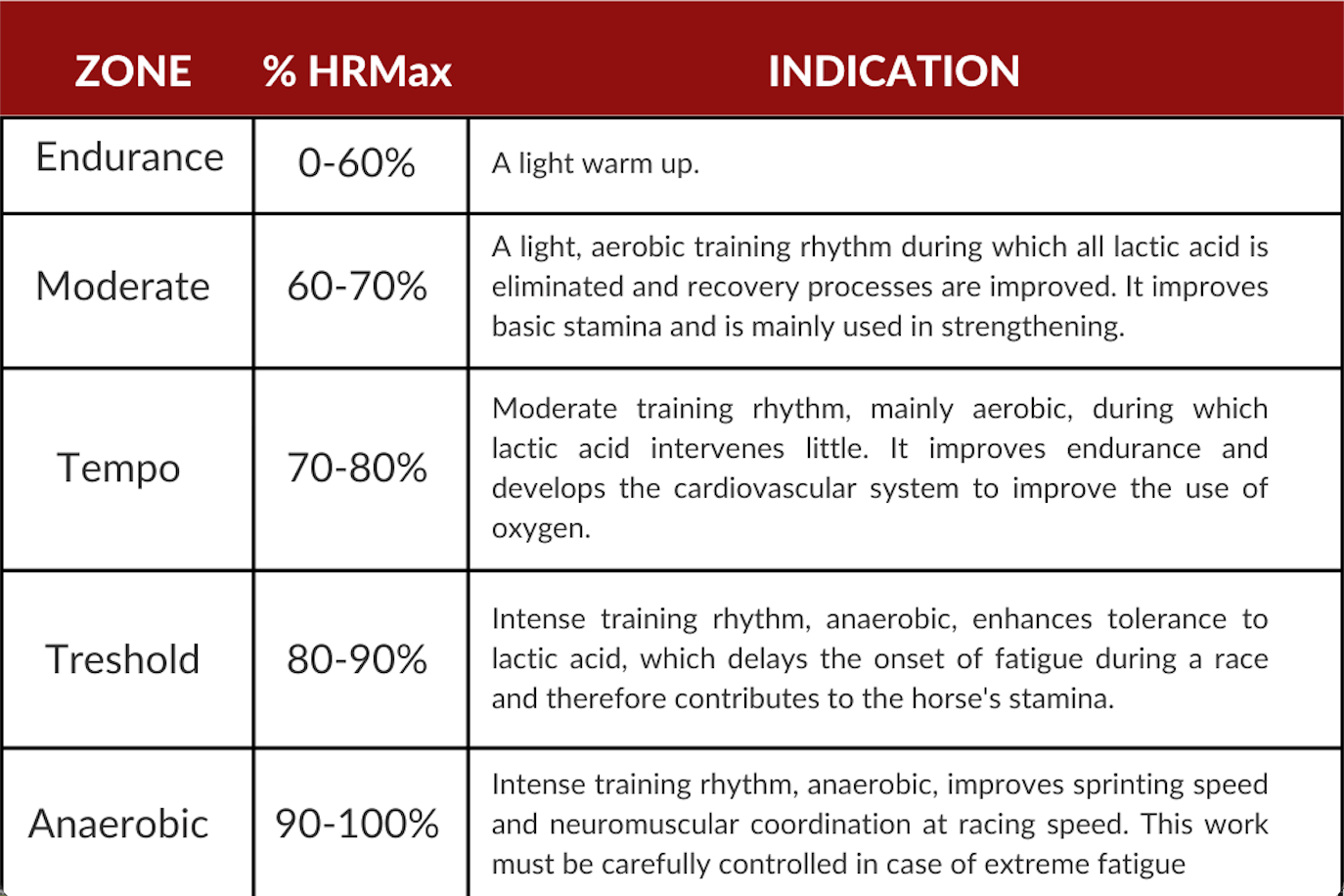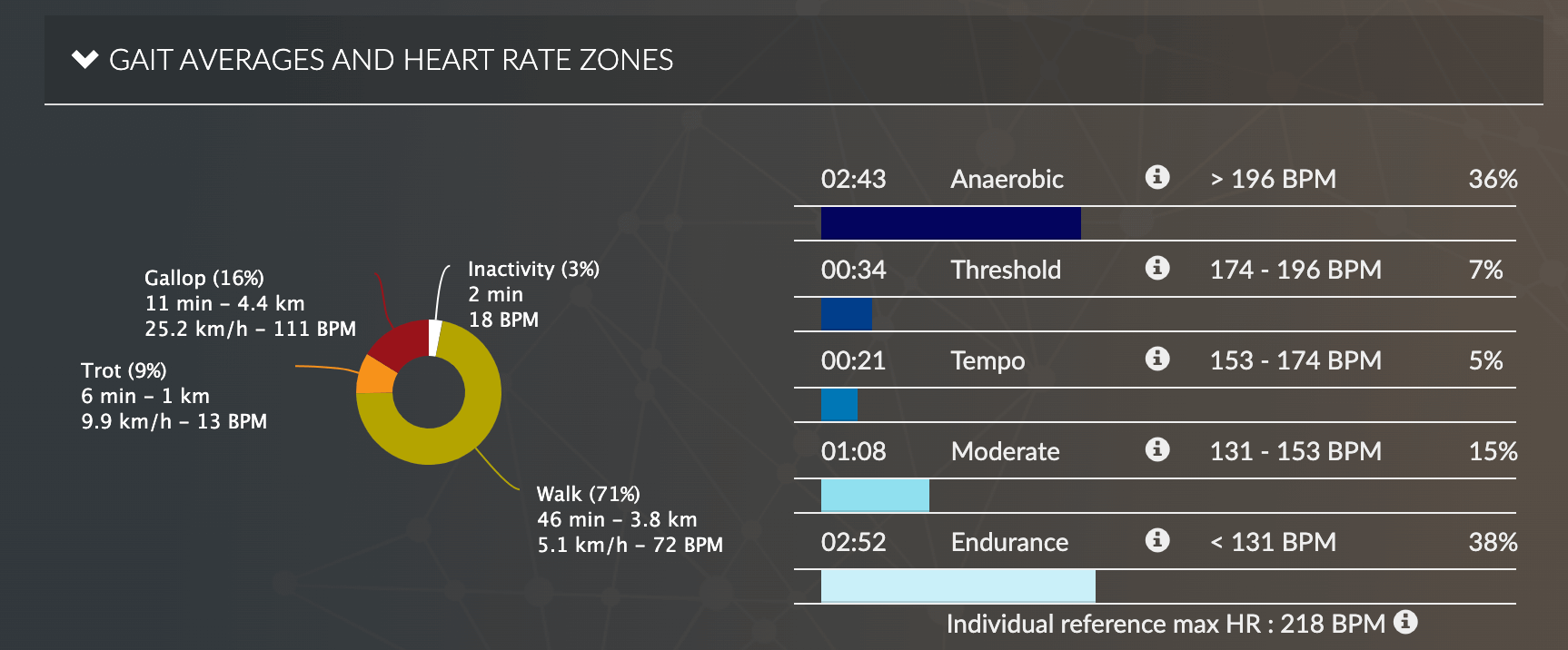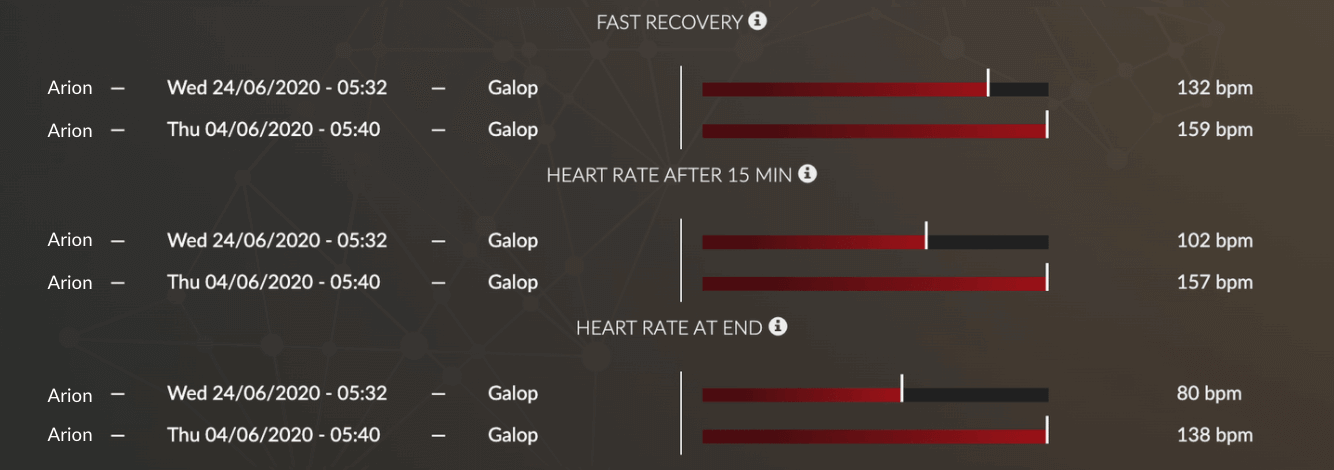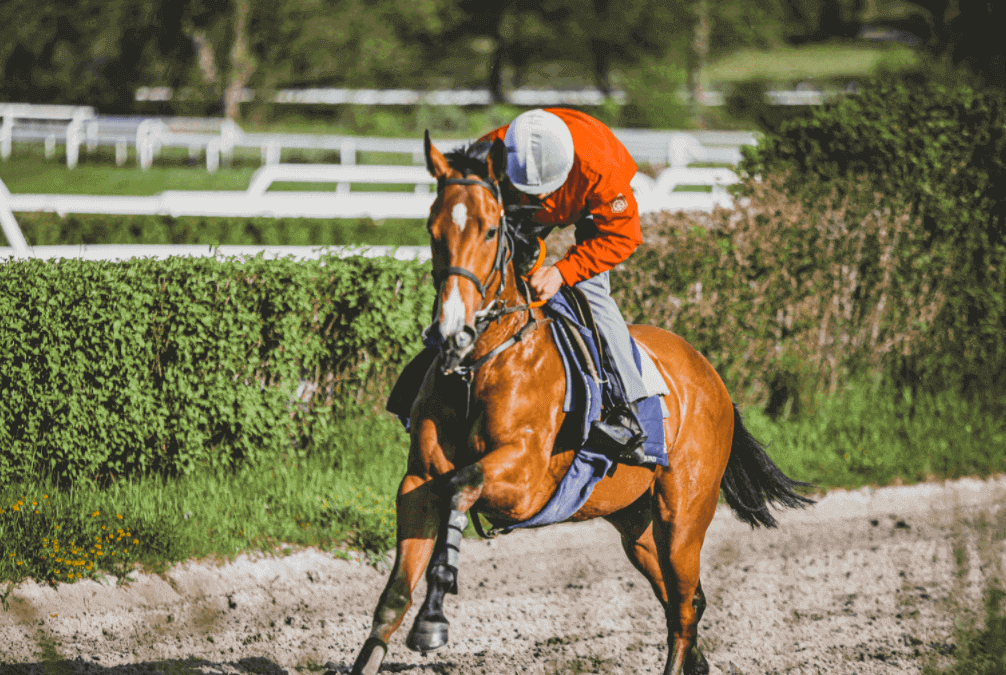Racehorses are true athletes who undergo intensive training. It is therefore essential to monitor and analyze the fitness of your horses to keep an eye on their health and to maximize their performance.
Indeed, fitness is an excellent performance indicator since it allows you to assess the horse’s physical capacities and consequently adapt the training intensity. In addition, racehorses’ fitness analysis allows for the detection of potential anomalies or warning signs of pathologies.
How to evaluate your racehorses’ fitness?
With these four frequently asked questions by trainers using Equimetre, you will find some important keys to analyzing your racehorses’ fitness.
1. Why should you measure your racehorses’ maximum heart rate?
The maximum heart rate (HRMax) is the maximum number of beats per minute that a horse’s heart can reach. HRmax is specific to the physiology of each horse and can decrease slightly with age. It is in no way correlated with performance. On average, it ranges between 204 and 241 BPM (Evans, 2007). By the way, it is important to investigate the cause of a heart rate exceeding 241 BPM because it may be a sign of a cardiac anomaly.
How do I know if my horse has been trained intensively?
To measure the intensity of a training session, you have to look at the heart rate during the effort and convert it into an HRmax percentage. Thus, knowing the horse’s HRmax is a must to assess his fitness. Indeed, a horse that has worked at 70% of its HRmax during a training session is able to work harder, while a horse that reaches 90% of its HRmax during the same training session has undergone intensive training. Still, thanks to regular and adapted training, he will surely manage to perform the same exercise with a lower heart rate: the horse’s fitness will improve.
In this example, Arion’s HRmax is 205 BPM and we notice that he spent 34% of his training with an effort heart rate exceeding 185 BPM, i.e. exceeding 90% of his HRmax. We can conclude that Arion underwent a high intensity training.
2. Effort zones: how can I know if my horse’s training is efficient?
There is of course no ready-made answer to this question as each horse is different. The effort zone to be reached depends mainly on the training goals.
First of all, it should be remembered that it is possible to differentiate several training intensity zones thanks to the HRmax:
- Up to 70% of HRmax: aerobic zone where the body draws its energy from the fat
- Between 70% and 80% of HRmax: alactic anaerobic zone where the body is still able to provide enough oxygen to eliminate acid lactic
- Between 80% and 90% of HRmax: MVA zone where the body starts to accumulate acid lactic
- Between 90 and 100% of HRmax: lactic anaerobic zone where the body accumulates a lot of acid lactic, the exercise become difficult for the muscle
Heart rate zones interpretation

A tool like Equimetre simplifies the task by directly calculating the time spent in each effort zone during training
How to analyze those heart rate zones?
Heart rate zones are excellent indicators of training intensity or horse’s ability to withstand the effort. Still, there is no typical pattern for knowing whether a training was effective or not. Interpretation becomes relevant when two training results or two horses undergoing a similar training are compared. If one horse spends more time in the anaerobic zone than another horse during a similar training, it means that the training is harder for him and he has a lower fitness level. Similarly, if the same horse is training at similar intensity as he was three months ago and his data shows that he is spending less time in the anaerobic zone, then his fitness has improved.
It is therefore possible to assess the effectiveness of a training program and to analyze the progression of your horses by analyzing the evolution of the time spent in the anaerobic zone.


In this example, Arion I and Arion II performed the same training. We notice that Arion I spent 36% of his training in the anaerobic zone while Arion II only spent 7% in this heart zone. The training was therefore much more intense for Arion I. This horse has a lower fitness level.
3. Is it true that speed and fitness go hand in hand?
Of course, speed is an essential factor in racing. The stopwatch analysis clearly indicates the horse’s performance, but it does not allow for an assessment of his fitness. However, by combining speed and heart rate data, it is possible to get information on the horse’s physical condition.
What speed data should I look at to analyze my horse’s fitness?
Speed at HRmax is an excellent indicator of how your horses are progressing or how they are performing compared to others. As mentioned earlier, HRmax is unique to each horse and therefore cannot be used to evaluate a horse’s progress. However, it is relevant to compare speed data at HRmax: the higher the speed when the maximum rate is reached, the better the horse’s fitness is. One can compare the evolution of a horse’s fitness by looking at the speed data at HRmax during a previous training, or even compare the fitness of two horses between them by looking at their speed at their respective HRmax.
V200 is the speed reached by a horse when its heart rate is 200 BPM. This parameter allows, in the same way as the speed at HRmax, to compare horses on a common basis or to objectify the progression of a horse during the season. An increasing V200 indicates better fitness, since a horse that runs faster at the same heart rate has better cardio.
Concrete example
During his training on the 19/11/2021, Arion reaches he reaches a speed at HRmax of 48,9 km/h and a V200 of 46,2 km/h.
During his training on the 18/02/2022, he reaches a speed at HRmax of 49,5km/h and a V200 of 57,6 km/h.
We notice that its speed at HRmax has slightly increased but above all, the evolution of his V200 jumps to the eyes. Indeed, for the same heart rate, he runs 11,4 km/h faster: his fitness has improved.

4. Is my horse ready to race?
Optimizing speed is great, but the horse must be trained to handle the intensity of a race and perform on the D day. Remember that a horse in good shape and health is a horse that recovers well from its effort. Therefore, to know if a horse is ready to race, it is interesting to analyze its recovery capacity. At the end of an effort, when the speed decreases, the heart rate generally remains high for a little while before slowing down strongly. This is the beginning of the recovery phase. It is relevant to analyze heart rate data during the fast recovery phase and the long one to have a global vision of the horse’s fitness.
How do I know if my horse is recovering well?
The recovery phase: During the fast recovery phase i.e when the speed has decreased drastically, the heart rate is supposed to drop. The greater the drop, the better the horse’s recovery is and the better the horse’s fitness is. In the same way, during the long recovery phase, the heart rate continues to drop. Thus, after 15 minutes, horses with better fitness will have fallen back to a heart rate close to that of rest.
We can compare two similar workout from Arion’s training. We notice that during the training of the 04/06/2022, he has a better fitness than during the training of the 24/06/2022. Indeed, his heart rate during the fast recovery went from 159 BPM to 132 BPM, after 15 minutes of recovery it went from 157 BPM to 102 BPM and once back at the stable, it went from 138 BPM to 80 BPM. His fitness improved.

The time it takes for the heart rate to drop: It reflects the ease or difficulty the horse has in handling the effort. Therefore, analyzing the time it takes for the heart rate to drop to 120 BPM may be relevant, especially in young horses. The longer the time it takes, the more difficult it is for the horse to tolerate the effort and the worse its fitness is. However, training will reduce the time it takes for the horse’s heart rate to drop and will improve its fitness.
The oxygen debt compensation time: During an intense effort – exceeding the threshold of 80% of the HRmax – the horse accumulates acid lactic because the body does not provide enough oxygen to eliminate it. At the end of the effort, when the speed decreases, the heart rate can remain high for a while: the heart continues to pump in order to compensate for the lack of oxygen accumulated during the effort by the horse. The shorter the oxygen debt compensation time is, the less difficult the effort was for the horse and therefore the less time he needs to recover. A low oxygen debt compensation time therefore corresponds to good fitness. If the horse tolerates training well, it may be worthwhile to increase the intensity of the next training session in order to continue to improve its abilities and performance.
Conclusion
There are many parameters to analyze the fitness of your horses, but all these parameters have one thing in common: heart rate analysis. Thus, working with a heart rate monitor like EQUIMETRE can be very useful in the analysis of the fitness of your horses. Although the analysis may seem difficult, Arioneo aims at simplifyingthings for you by offering a system that is easy to use and by accompanying you on a daily basis in the analysis of the data. Click here to see an analysis report produced by our teams and included in our offer.
Which EQUIMETRE parameters to analyze to evaluate your racehorses’ fitness?
Our team of Data Success Managers recommends quantifying the intensity of your horse’s effort as a first step.
Quantify effort intensity
- Maximum heart rate: the number of beats per minute that a horse’s heart can reach. The HRmax is unique to each horse’s physiology and may decrease somewhat with age. It has no impact on performance. It ranges between 204 and 241 BPM on average. If a horse hits its maximal heart rate during an effort, we may assume that the effort was quite strenuous. This information is essential for quantifying the effort. It provides the basis for all fitness evaluations. When a horse runs 600m in fewer than 42 seconds, our algorithms at Arioneo automatically compute the HRmax.
- Time spent in zone 5: this is the total amount of time in seconds when the heart rate is above 90% of its maximum. The effort zone to be reached is mostly influenced by the training goals. Zone 5 is the most intensive effort zone.
- Best 200m: this is the time in seconds to run the fastest 200m in the entire training session. If this time is less than 11/12 seconds, we can consider that the training was of high intensity.
Secondly, our team of Data Success Managers recommends assessing the horse’s level of recovery based on the intensity of the work performed.
Assess recovery levels
- Fast recovery in percentage of HRmax : this is the percentage of fast recovery heart rate. This percentage enables us to compare horses regardless of their HRmax level. For example, if a horse’s heart rate is 217 BPM and his heart rate soon after exercise is 118 BPM, his recovery after exercise will be (118 / 217) x 100 = 54%. On average, this figure is roughly 55%. This information allows us to assess how well the horse handled the effort. If this figure is close to the average, the horse took the effort rather effectively. If, on the other hand, this value is abnormally high, it indicates that your horse has struggled with the required exercise.
- Time to 120 or 100 BPM : it’s the time time in seconds from the end of last highest exercise to reach 120 or 100 BPM. The longer this time, the more difficult it is for the horse to withstand the effort. This allows us to go into more depth in our recovery analysis.
- 15 minutes recovery in percentage of HRmax : it’s the percentage of the 15 minutes recovery. On average, this value is around 50%. Heart rate continues to drop during the long recovery phase. Thus, horses in better shape will have returned to a heart rate close to resting after 15 minutes.
Keywords: fitness, racehorse, heart rate, horse fitness analysis, speed, analysis, recovery, effort zones



